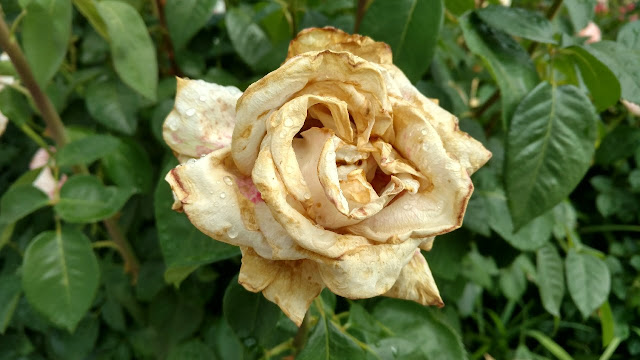
Foggy conditions prompted recent outbreak

|
| Gray mold, also called botrytis, ruins rose blooms. (Photo: Debbie Arrington) |
Gray mold has me feeling blue. I love autumn roses. Hundreds of rosebuds in my garden had me envisioning fresh bouquets this holiday season.
But most of these November roses will never open. Instead, they turn to mush on the stem.
The reason? Gray mold. That’s the descriptive nickname of the fungal disease botrytis. It’s common in November rose gardens, and this season’s outbreak looks particularly yucky.
Rain storms in early November kicked it into full gear. Recent foggy conditions nurtured its rapid advancement.
Gray mold – which actually looks more tan or brown on the rosebud – needs moisture for growth in plant tissues, particularly tender flower petals. To prevent outbreaks, keep flower buds dry. That’s all but impossible on damp, foggy days.
Gray mold starts out looking like pink measles or brownish water spots on light-colored flowers. Those brown spots rapidly grow until the fungus consumes the whole petal. The flower never fully opens.
Gray mold also attacks African violet, asters, begonia, carnation, chrysanthemum, cyclamen, cymbidium, gerbera, geranium, gladiolus, hydrangea, marigolds, orchids, petunia, poinsettia, primrose, ranunculus, snapdragon, zinnia and many other garden favorites.
According to UC Integrated Pest Management program, the best control of gray mold is “good sanitation.” Clip off infected blooms, put them in a plastic bag and dispose in the trash. Do not compost them; that just recycles the spores back into the garden.
Pick up fallen blooms and petals around the bush and dispose of them, too. After pruning when roses are dormant, rake out old mulch and fallen foliage. (This contains other fungal spores, too, for powdery mildew, rust, black spot and other rose diseases.) Then dispose of that old mulch and replace with fresh mulch.
For more information on gray mold, check out these pest notes from UC IPM: http://ipm.ucanr.edu/PMG/r280100511.html
Comments
0 comments have been posted.Sacramento Digs Gardening to your inbox.
Food in My Back Yard Series
May 6: Maintain soil moisture with mulch for garden success
April 29: What's (already) wrong with my tomato plants?
April 22: Should you stock up on fertilizer? (Yes!)
April 15: Grow culinary herbs in containers
April 8: When to plant summer vegetables
April 1: Don't be fooled by these garden myths
March 25: Fertilizer tips: How to 'feed' your vegetables for healthy growth
March 18: Time to give vegetable seedlings some more space
March 11: Ways to win the fight against weeds
March 4: Potatoes from the garden
Feb. 25: Plant a fruit tree now -- for later
Feb. 18: How to squeeze more food into less space
Feb. 11: When to plant? Consider staggering your transplants
Feb. 4: Starting in seed starting
Sites We Like
Garden Checklist for week of May 4
Enjoy this spring weather – and get gardening!
* Plant, plant, plant! It’s prime planting season in the Sacramento area. Time to set out those tomato transplants along with peppers and eggplants. Pinch off any flowers on new transplants to make them concentrate on establishing roots instead of setting premature fruit.
* Direct-seed melons, cucumbers, summer squash, corn, radishes, pumpkins and annual herbs such as basil.
* Harvest cabbage, lettuce, peas and green onions.
* In the flower garden, direct-seed sunflowers, cosmos, salvia, zinnias, marigolds, celosia and asters. (You also can transplant seedlings for many of the same flowers.)
* Plant dahlia tubers. Other perennials to set out include verbena, coreopsis, coneflower and astilbe.
* Transplant petunias, marigolds and perennial flowers such as astilbe, columbine, coneflowers, coreopsis, dahlias, rudbeckia and verbena.
* Keep an eye out for slugs, snails, earwigs and aphids that want to dine on tender new growth.
* Feed summer bloomers with a balanced fertilizer.
* For continued bloom, cut off spent flowers on roses as well as other flowering plants.
* Add mulch to the garden to maintain moisture. Mulch also cuts down on weeds. But don’t let it mound around the stems or trunks of trees or shrubs. Leave about a 6-inch to 1-foot circle to avoid crown rot or other problems.